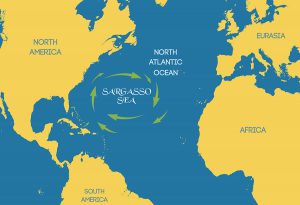As we observed last summer and the years before that, Miami-Dade County’s beaches received large influxes of sargassum seaweed on a consistent basis. Florida joins the larger Caribbean in experiencing this phenomenon, and we are trying to figure out ways to manage this naturally-occurring seaweed.
If you’ve ever swam, fished, or boated around sargassum, you may be aware that it is a highly productive ecosystem in and of itself. The seaweed can clump together as a large mat, forming a protective layer between predators in the air and potential prey in the water. Mahi Mahi or dolphinfish forage underneath the mats, which is really cool to see. Sea turtle hatchlings also use sargassum to hide from predators.
Mass sargassum beachings have proven problematic. We have two tidal cycles in Florida, bringing sargassum ashore twice a day. When the tide goes out, the seaweed remains on the beach, accumulating faster than beach management crews can remove it. The sargassum that ends up stranded on the beach creates a large, soggy area that beachgoers have to walk through just to access the water. While the seaweed itself is not toxic, as it sits upon the shore, it begins to decompose. Organic material trapped in the seaweed, as well as small critters and creatures that get trapped in it can be smothered and die, intensifying the smell. The result is an odor that is not only unpleasant but can be hazardous to people with respiratory trouble. If the sargassum mats remain stagnant over certain locations for a period of time, they can actually smother seagrasses and corals from sunlight, which could lead to negative consequences for these important organisms.
We know that historically, sargassum originates in the Sargasso Sea, an area of the Atlantic Ocean. The pelagic or free-floating seaweed travels largely through ocean currents and prevailing winds. However, scientists are identifying potential new sources of this seaweed, notably, nutrient loading from the Amazon River. These nutrients include nitrogen and phosphorus, which are ingredients commonly found in fertilizers and pesticides. Sargassum mats and subsequent beachings tend to be higher during the summer months. These months coincide with sea turtle nesting season, a significant ecological factor to consider.
The standard ways to remove sargassum include using a tractor with a blade to flatten out the large, accumulated piles, or using a front-end loader to remove the piles from where they get stuck on the beach. Since sea turtle nest protection is a major part of Miami-Dade County’s beach management, sargassum removal activities require cooperation at higher levels with the Florida Department of Environmental Protection. Miami-Dade County Parks, Recreation, and Open Spaces (PROS) manage 17 miles of beaches, including those of the City of Miami Beach, a major tourist destination. PROS and other entities are investigating management approaches other than removal, as well as cooperative ways to address and communicate about sargassum.

 0
0
